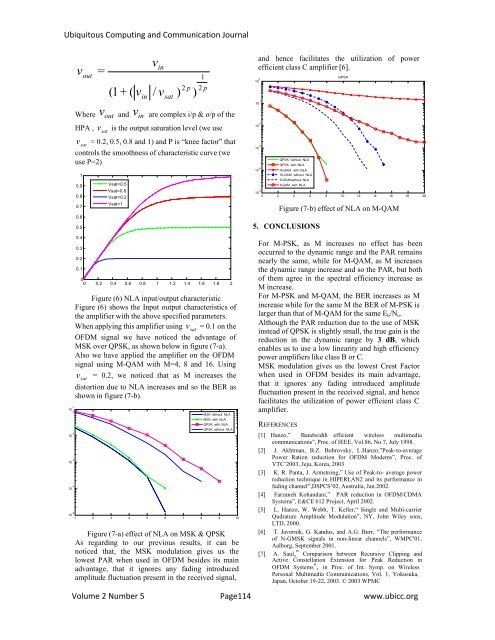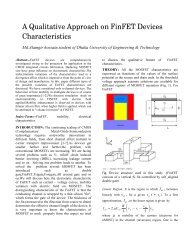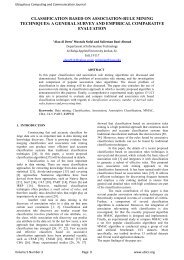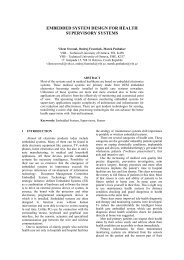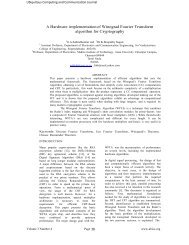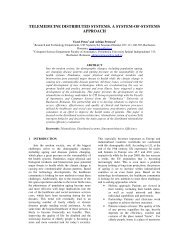Low Crest Factor Modulation Techniques for Orthogonal Frequency ...
Low Crest Factor Modulation Techniques for Orthogonal Frequency ...
Low Crest Factor Modulation Techniques for Orthogonal Frequency ...
Create successful ePaper yourself
Turn your PDF publications into a flip-book with our unique Google optimized e-Paper software.
Ubiquitous Computing and Communication Journal<br />
v out<br />
=<br />
and hence facilitates the utilization of power<br />
v in<br />
efficient class C amplifier [6].<br />
1<br />
QPSK<br />
0<br />
10<br />
(1 + ( v in<br />
/ v sat ) 2 p ) 2 p<br />
Where v out and v in<br />
are complex i/p & o/p of the<br />
HPA , v sat<br />
is the output saturation level (we use<br />
v sat<br />
= 0.2, 0.5, 0.8 and 1) and P is “knee factor” that<br />
controls the smoothness of characteristic curve (we<br />
use P=2)<br />
1<br />
0.9<br />
0.8<br />
0.7<br />
0.6<br />
Vsat=0.5<br />
Vsat=0.8<br />
Vsat=0.2<br />
Vsat=1<br />
Volume 2 Number 5 Page 114 www.ubicc.org<br />
-1<br />
10<br />
-2<br />
10<br />
-3<br />
10<br />
QPSK without NLA<br />
QPSK with NLA<br />
10 -4 16-QAM with NLA<br />
16-QAM without NLA<br />
8-QAMwithout NLA<br />
8-QAM with NLA<br />
0.5 5. CONCLUSIONS<br />
0.4<br />
-5<br />
10<br />
0 2 4 6 8 10 12 14 16 18 20<br />
Figure (7-b) effect of NLA on M-QAM<br />
For M-PSK, as M increases no effect has been<br />
0.3<br />
0.2<br />
0.1<br />
0<br />
0 0.2 0.4 0.6 0.8 1 1.2 1.4 1.6 1.8 2<br />
occurred to the dynamic range and the PAR remains<br />
nearly the same, while <strong>for</strong> M-QAM, as M increases<br />
the dynamic range increase and so the PAR, but both<br />
of them agree in the spectral efficiency increase as<br />
M increase.<br />
Figure (6) NLA input/output characteristic For M-PSK and M-QAM, the BER increases as M<br />
Figure (6) shows the Input output characteristics of increase while <strong>for</strong> the same M the BER of M-PSK is<br />
the amplifier with the above specified parameters. larger than that of M-QAM <strong>for</strong> the same E b /N o .<br />
When applying this amplifier using v sat<br />
= 0.1 on the<br />
Although the PAR reduction due to the use of MSK<br />
instead of QPSK is slightly small, the true gain is the<br />
OFDM signal we have noticed the advantage of reduction in the dynamic range by 3 dB, which<br />
MSK over QPSK, as shown below in figure (7-a). enables us to use a low linearity and high efficiency<br />
Also we have applied the amplifier on the OFDM power amplifiers like class B or C.<br />
signal using M-QAM with M=4, 8 and 16. Using MSK modulation gives us the lowest <strong>Crest</strong> <strong>Factor</strong><br />
v sat<br />
= 0.2, we noticed that as M increases the when used in OFDM besides its main advantage,<br />
-1<br />
10<br />
-2<br />
10<br />
-3<br />
10<br />
-4<br />
10<br />
distortion due to NLA increases and so the BER as<br />
shown in figure (7-b).<br />
MSK without NLA<br />
MSK with NLA<br />
QPSK with NLA<br />
QPSK without NLA<br />
-5<br />
10<br />
1 2 3 4 5 6 7 8 9 10<br />
Figure (7-a) effect of NLA on MSK & QPSK<br />
As regarding to our previous results, it can be<br />
noticed that, the MSK modulation gives us the<br />
lowest PAR when used in OFDM besides its main<br />
advantage, that it ignores any fading introduced<br />
amplitude fluctuation present in the received signal,<br />
that it ignores any fading introduced amplitude<br />
fluctuation present in the received signal, and hence<br />
facilitates the utilization of power efficient class C<br />
amplifier.<br />
REFERENCES<br />
[1] Hanzo,” Bandwidth efficient wireless multimedia<br />
communications”, Proc. of IEEE, Vol.86, No.7, July 1998.<br />
[2] J. Akhtman, B.Z. Bobrovsky, L.Hanzo,”Peak-to-average<br />
Power Ration reduction <strong>for</strong> OFDM Modems”, Proc. of<br />
VTC’2003, Jeju, Korea, 2003<br />
[3] K. R. Panta, J. Armstrong,” Use of Peak-to- average power<br />
reduction technique in HIPERLAN2 and its per<strong>for</strong>mance in<br />
fading channel”,DSPCS’02, Australia, Jan.2002.<br />
[4] Farzaneh Kohandani,” PAR reduction in OFDM/CDMA<br />
Systems”, E&CE 612 Project, April 2002.<br />
[5] L. Hanzo, W. Webb, T. Keller,“ Single and Multi-carrier<br />
Qudrature Amplitude <strong>Modulation</strong>”, NY, John Wiley sons,<br />
LTD, 2000.<br />
[6] T. Javornik, G. Kandus, and A.G. Burr, “The per<strong>for</strong>mance<br />
of N-GMSK signals in non-linear channels”, WMPC'01,<br />
Aalborg, September 2001.<br />
[7] A. Saul,” Comparison between Recursive Clipping and<br />
Active Constellation Extension <strong>for</strong> Peak Reduction in<br />
OFDM Systems”, in Proc. of Int. Symp. on Wireless<br />
Personal Multimedia Communications, Vol. 1, Yokusuka,<br />
Japan, October 19-22, 2003. © 2003 WPMC


